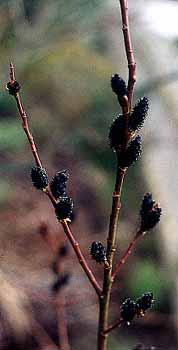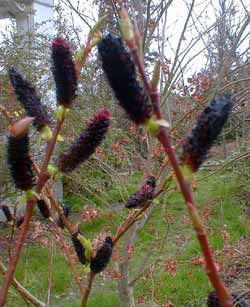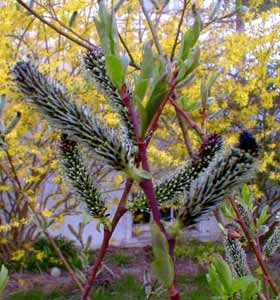
Black Pussy Willow
"Ah, & nowadays I myself am quite unsteady
Can't walk home after a friendly drinking session.
There did I see a pussy willow, over there a pine,
And by the snowstorm sang them songs about summer."
-Sergey AleksandrovichYesenin
(1895-1925)
(1895-1925)
Glasshouse Works Nursery's catalog told the amusing story of how late one winter a customer called in hysterics because one of her shrubs had been attacked by hundreds of black wooly worms. The pusses on Salix gracilistyla var melanostachys do look like black woolybears perched all along the limbs, standing straight up on their hindquarters. These appear well ahead of the leaves in late winter, as shown in the mid-February (2003) first portrait & early March (2004) second portrait.
 The male catkins are rounder & showier, having the red anthers, & gradually turn from purply-black to yellow from pollen. Sometimes young pusses wear little "hats" which is the bud-casing balanced on top, though wind shaking the branches knocks most of those off. The second photo shows not only a couple red-anthered pusses, but also one at the middle left-hand side of the portrait still wearing the brown dunce's cap.
The male catkins are rounder & showier, having the red anthers, & gradually turn from purply-black to yellow from pollen. Sometimes young pusses wear little "hats" which is the bud-casing balanced on top, though wind shaking the branches knocks most of those off. The second photo shows not only a couple red-anthered pusses, but also one at the middle left-hand side of the portrait still wearing the brown dunce's cap.The third late-March (2004) photo shows mature pusses with young leaves beginning to appear. The yellow-flowering shrub across the path in the background is a huge forsythia. The pusses remain striking until the last week of March or first week of April. A late March rainstorm can finish them off a few days sooner than otherwise. From mid-March to April the pusses are slowly joined by leaves which are long & faintly serated or ruffly, silvered on the underside, & make for a very pleasant loose-limbed shrub.
This multi-stemmed willow is a cut above similar shrub-willows, due not only to late winter & early spring's marvelous purblish-black catkins with red anthers, but also for the winter color of the twigs, which are red & black but slowly turn back to green for spring through autumn.
 The natural species has golden catkins instead of black, & is native of Japan, Korea & Manchuria. The black variant originated as a Japanese garden ornamental. In Japan it is called Kurome or Kuroyanagi, "Kuro" meaning "darkness," with associations with the underworld or Land of the Dead.
The natural species has golden catkins instead of black, & is native of Japan, Korea & Manchuria. The black variant originated as a Japanese garden ornamental. In Japan it is called Kurome or Kuroyanagi, "Kuro" meaning "darkness," with associations with the underworld or Land of the Dead.It prefers full sun, but does well in partial shade here in Zone 8. It requires regular watering with good drainage. It manages to do well in ground wetter than ideal, but does not like to dry out. It is suitable for USDA zones 5-9, but will be fragile where temperatures fall below ten degrees.
It remains always a little brittle so should be situated in a location where neither high winds nor people will be apt to break off pieces of it. Its outstretching twiggy habit eventually makes it untidy & thin-looking, & for mature specimens it is helpful to take limbs to use as cut flowers indoors, as a means of keeping it lightly pruned back to size.
About every four years it should be hard-pruned, which will keep it compact & insure production of the largest possible catkins. If it never has a hard prune it will not only produce smaller catkins, but the limbs will be increasingly brittle, & quite likely break in uncontrolled ways that harm the overall structural appearance.
As with so many willow shrubs, it is susceptible to insect attack & other problems which hard pruning at long intervals helps it resist. The root system as well as the limb spread can be fairly far-ranging & the roots can outcompete nearby shrubs for a fair share of water, so should not be placed too near anything overly fragile.
Growth can be surprisingly rapid, so if you start with a small one, you'll have a pretty good-sized shrub in only one year.